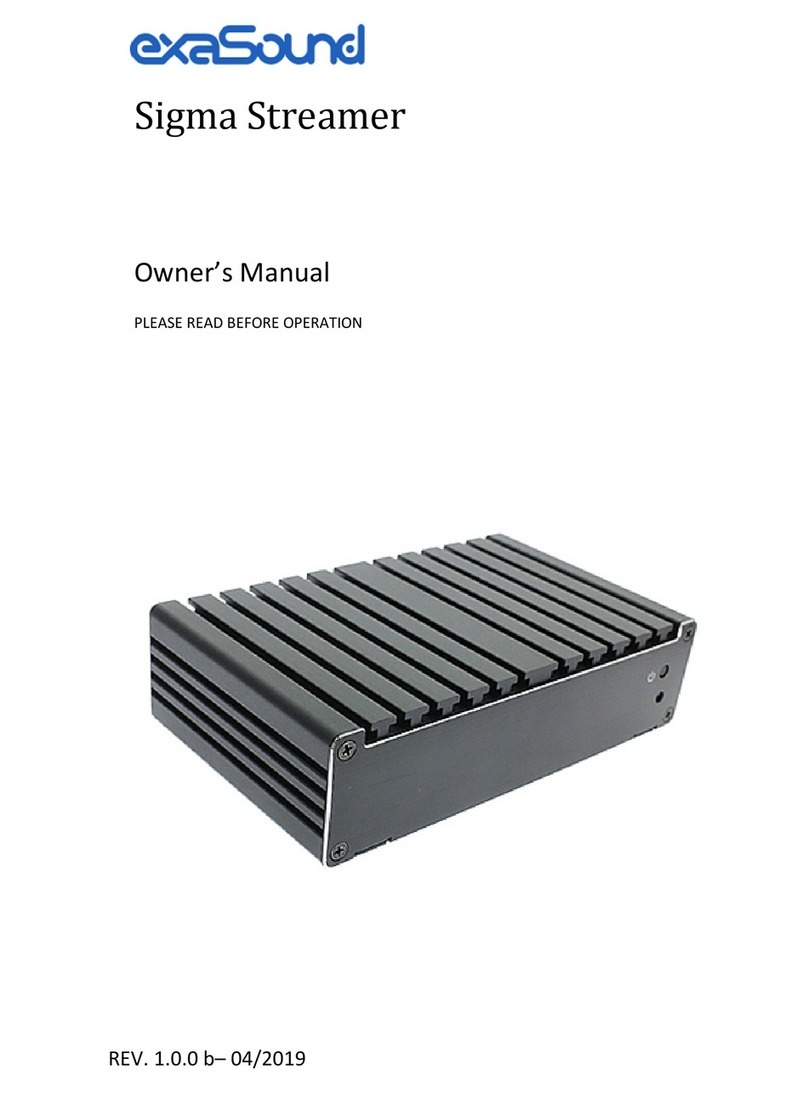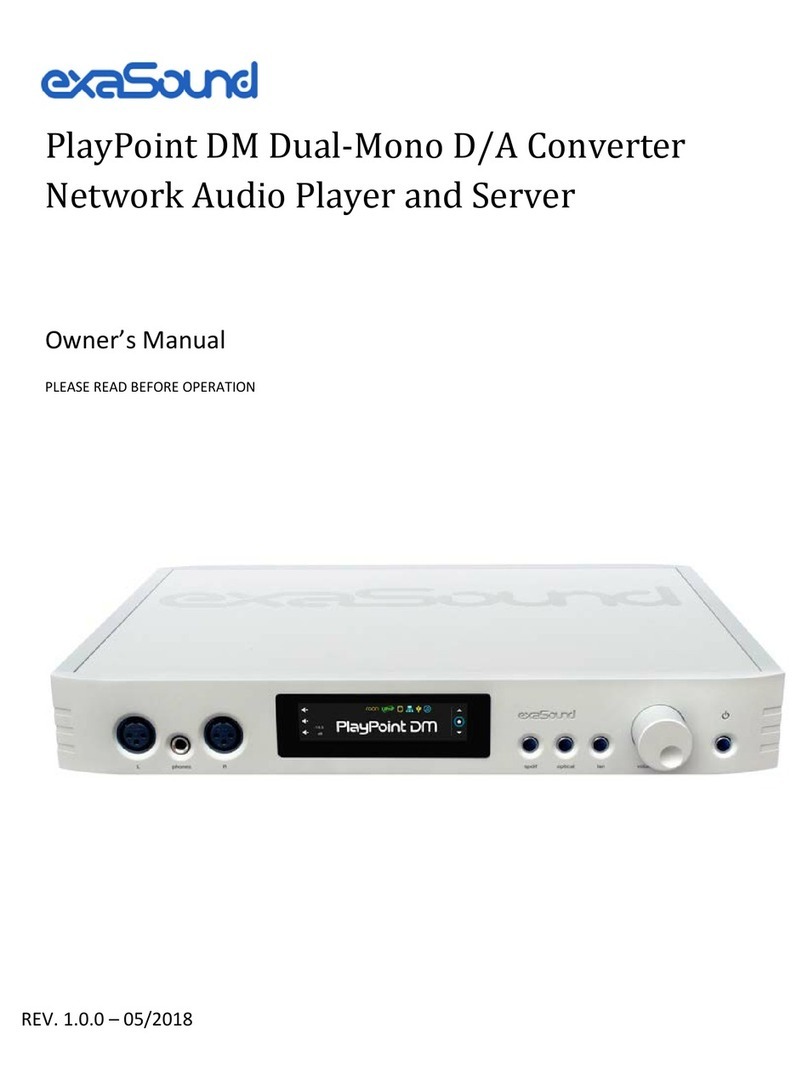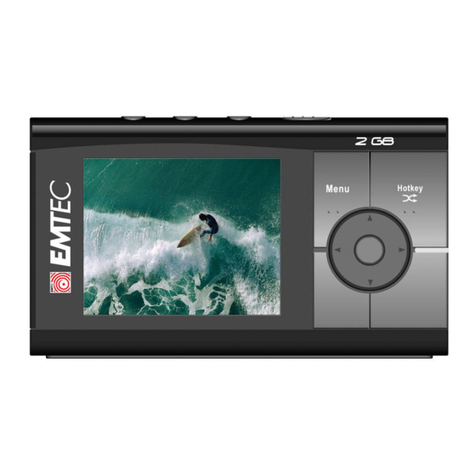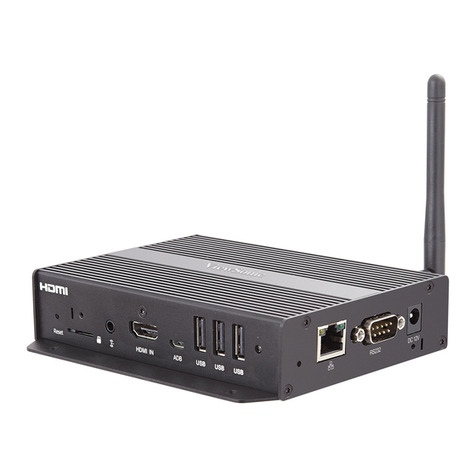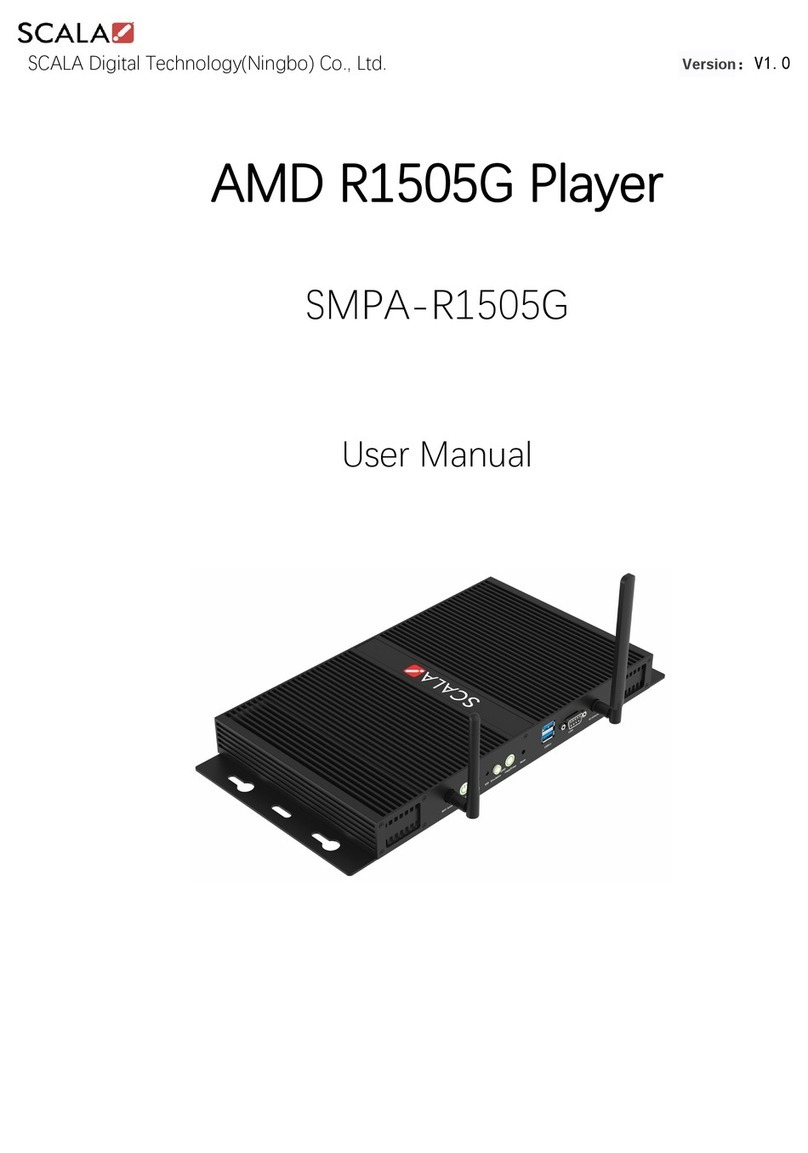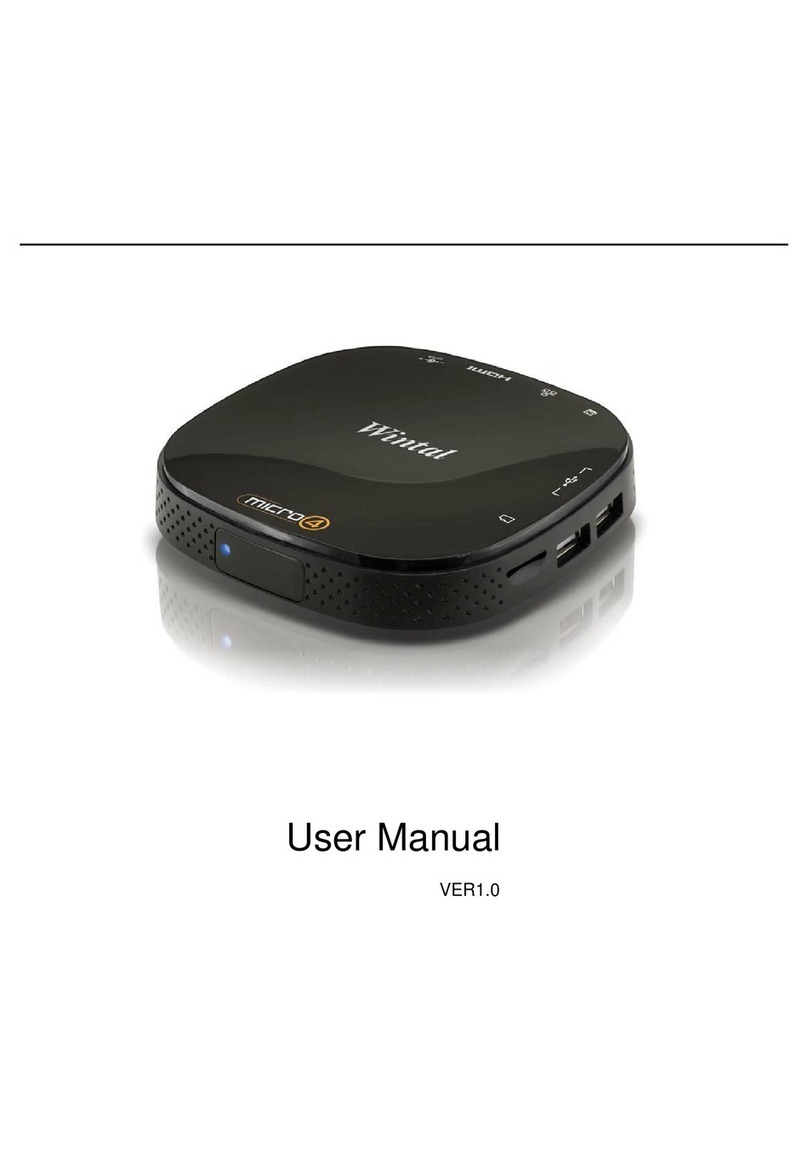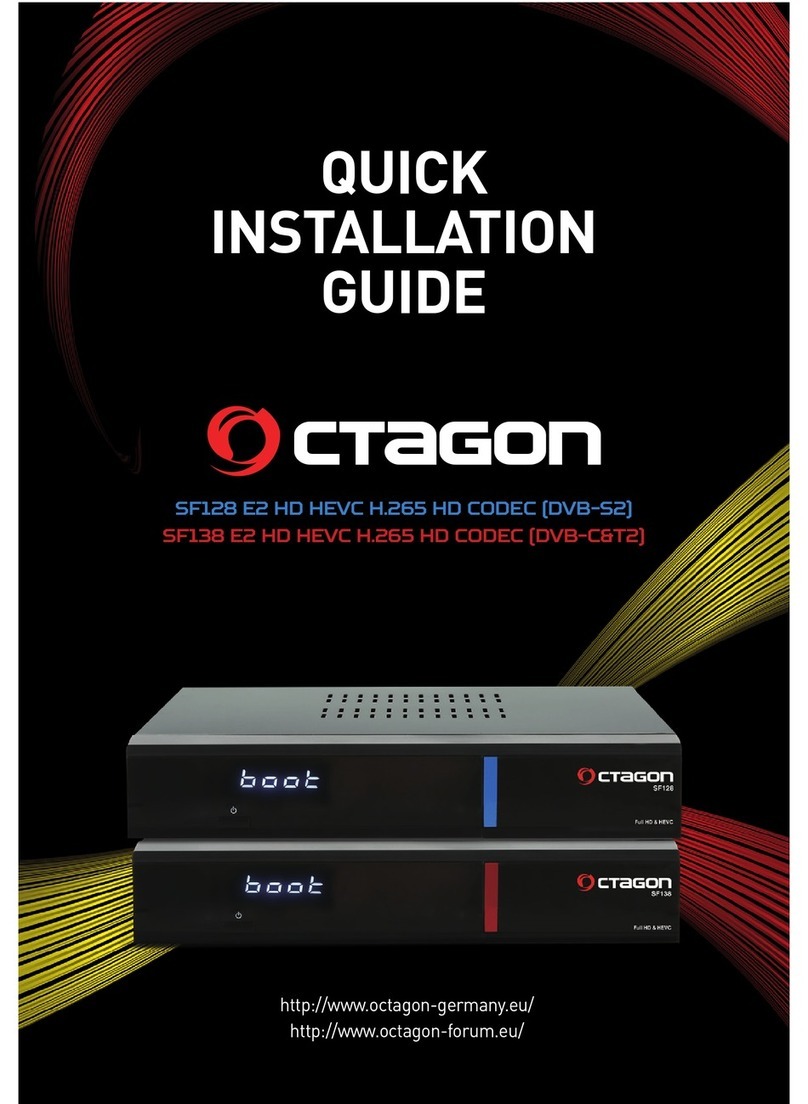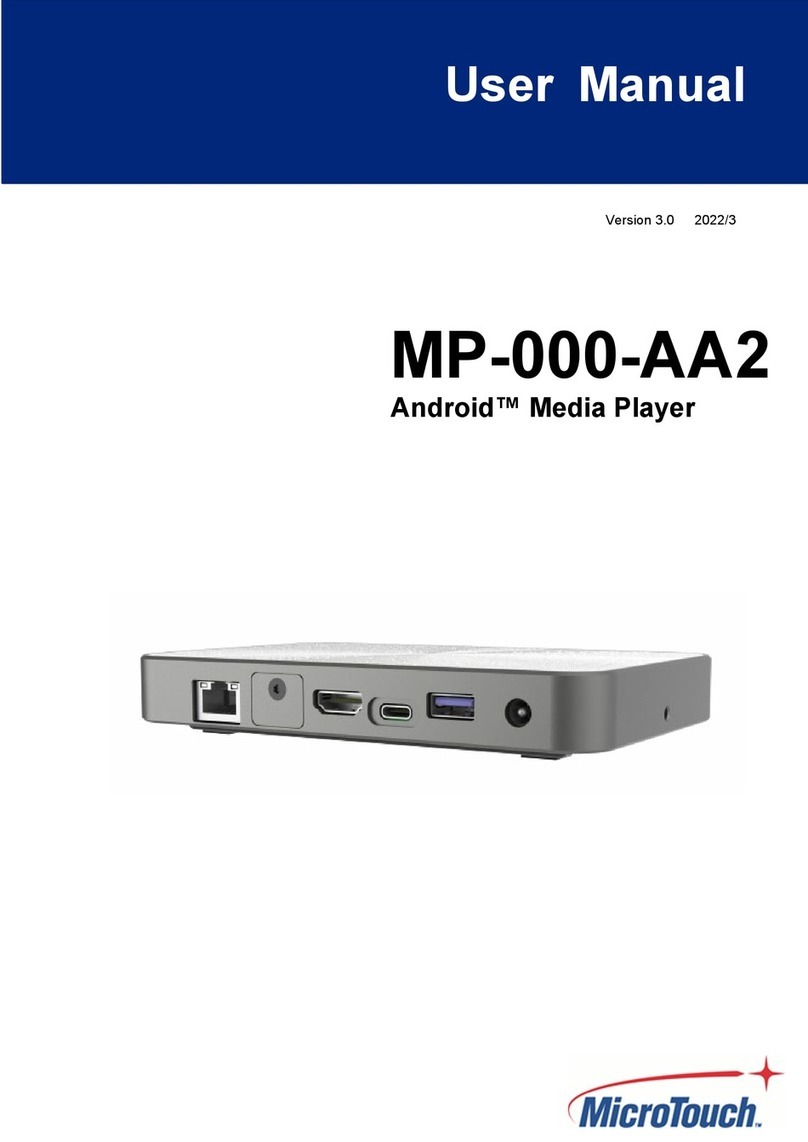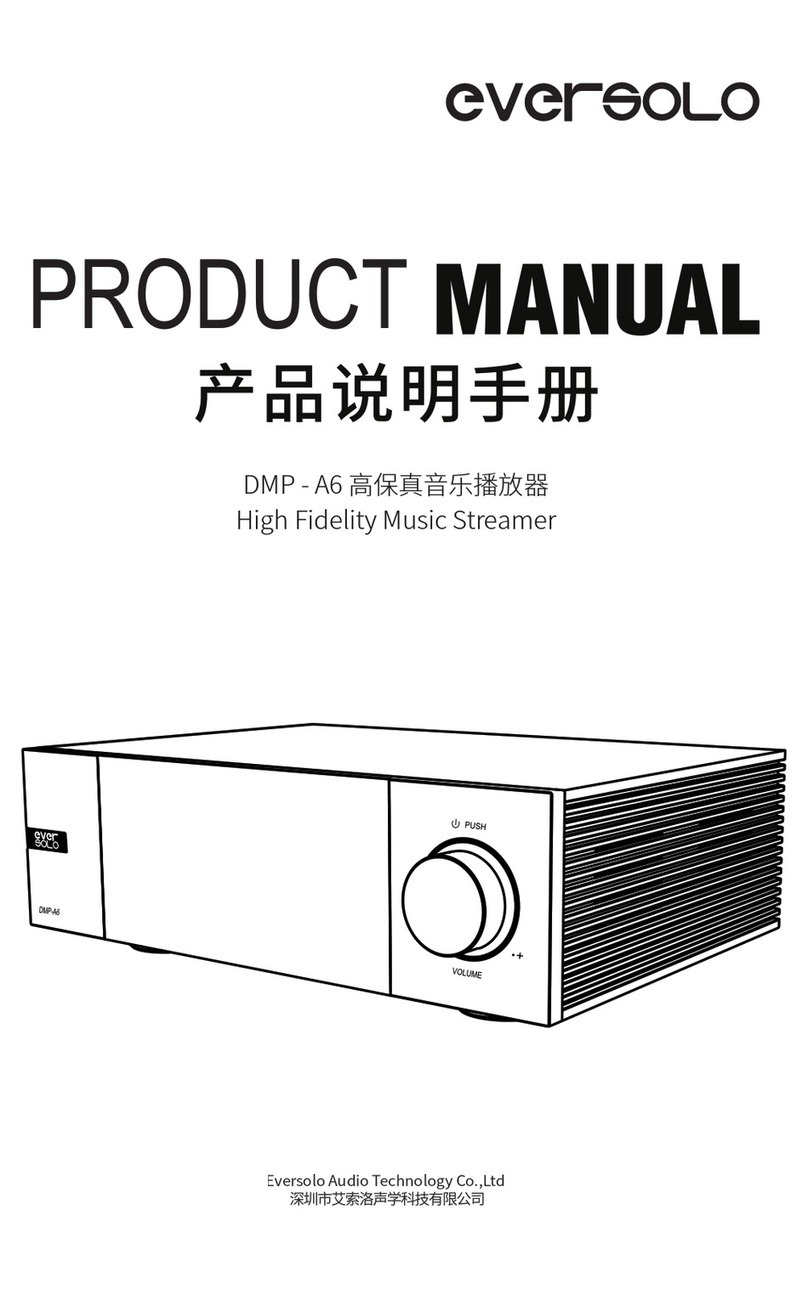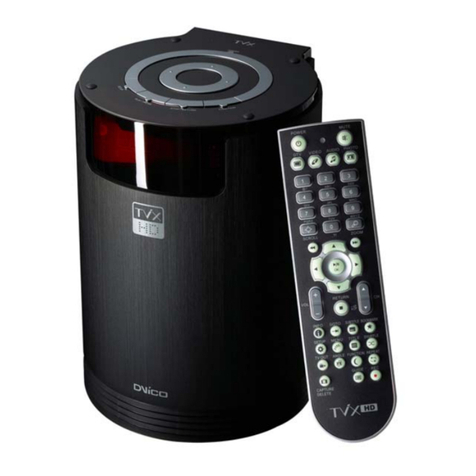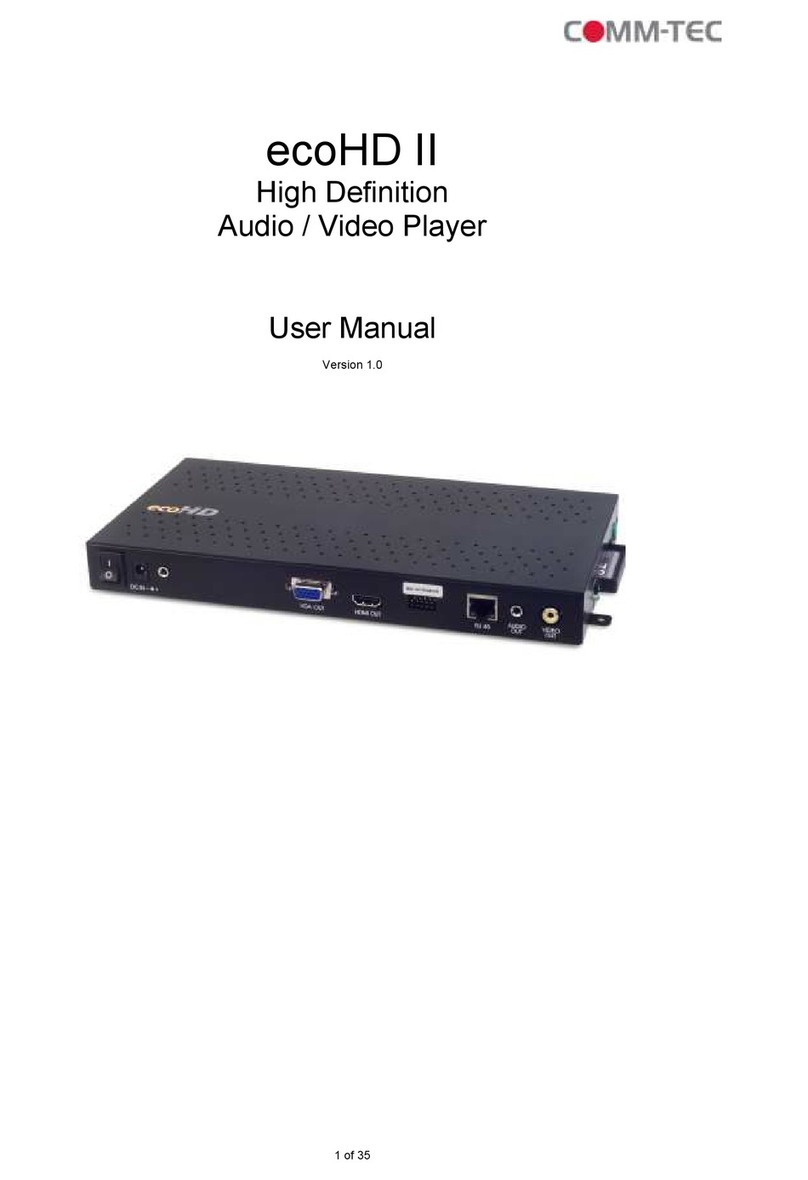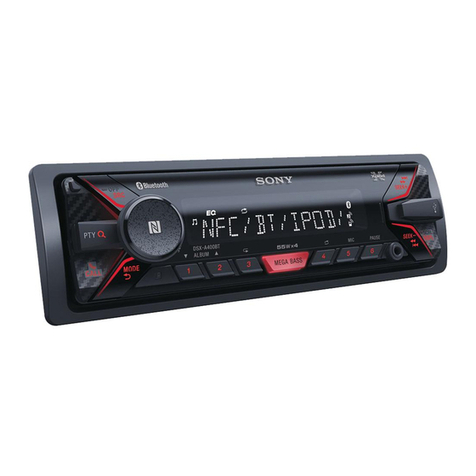exaSound s82 Mark II User manual

s82 Mark II Streaming DAC and Roon Server
Owner’s Manual
PLEASE READ BEFORE OPERATION
DSD 512/24.576 MHz PCM 32bit/384 kHz MQA 24 bit/384 kHz
REV. 2.0.1 – 03/2023

Page | 2
Table of Contents
Welcome ....................................................................................................................................................... 5
Package Contents.......................................................................................................................................... 6
Proper Device Placement.............................................................................................................................. 6
Overview ....................................................................................................................................................... 7
Features for Sonic Fidelity............................................................................................................................. 8
Front and Rear Panels.................................................................................................................................10
Infrared Remote Control.............................................................................................................................11
Connecting the s82 Mark II Streaming DAC and Roon Server ....................................................................12
Connecting the Digital Inputs ........................................................................................................ 12
Connecting the Line Outputs ......................................................................................................... 12
Connecting TV, USB keyboard and Mouse (Optional) ................................................................... 12
Trigger Output................................................................................................................................13
Direct Connection to Analogue Power Amplifier........................................................................... 13
Power Supply ................................................................................................................................. 13
Single Power Supply Configuration................................................................................................ 13
Connecting Additional Linear Power Supply for the DAC Analogue Stages ..................................13
Surge Protectors ............................................................................................................................14
Isolating the Cable TV Ground ....................................................................................................... 14
How to Use the s82 Mark II streaming DAC and Roon Server....................................................................15
Roon Ready Network Player ..........................................................................................................15
Tidal Connect Player ...................................................................................................................... 15
USB DAC ......................................................................................................................................... 16
UPnP /OpenHome Player and Audio Library Server......................................................................16
Network Audio Adapter for HQPlayer ...........................................................................................16
AirPlay Player ................................................................................................................................. 16
Bluetooth Music Player.................................................................................................................. 16
Web Streaming Player ...................................................................................................................16
Playing Music from Stereo SPDIF Sources .....................................................................................17
Quick Start Guide ........................................................................................................................................18
Proper Device Placement............................................................................................................... 18
Initial Start-up ................................................................................................................................ 18
Configuring a Wi-Fi Connection to the Home Network (Optional)................................................18
Using the exaSound s82 Mark II with Roon ...................................................................................19

Page | 3
Using the exaSound s82 Mark II with Tidal Connect .....................................................................19
Using the exaSound s82 Mark II with UPnP................................................................................... 19
Using the exaSound s82 Mark II with HQPlayer ............................................................................19
Using the exaSound s82 Mark II with AirPlay ................................................................................20
Windows ASIO Driver Setup ..........................................................................................................21
exaSound Dashboard (Windows)................................................................................................... 21
Mac OS Driver Setup......................................................................................................................22
exaSound Menu Icon (Mac OS)...................................................................................................... 22
Audio-MIDI Setup...........................................................................................................................23
s82 Mark II Configuration ...........................................................................................................................24
Input Selection ...............................................................................................................................26
Device Information ........................................................................................................................26
Firmware Updates..........................................................................................................................27
Settings Menu................................................................................................................................28
Wi-Fi Configuration........................................................................................................................28
Multi-room Configuration and Using a Custom Device Name ...................................................... 30
Ethernet Connection with Manual IP Address............................................................................... 31
Switching Between Wireless and Wired Network Connection......................................................32
Resetting the Network Connection to Factory Defaults................................................................ 32
Sharing Attached USB Drives on the Network...............................................................................33
General Settings Page .................................................................................................................... 35
Power Saving Mode Timeout......................................................................................................... 36
Advanced Settings - Audio Optimisations...................................................................................... 36
Advanced Settings - SPDIF and TOSLINK Lock................................................................................ 37
Advanced Settings - DAC Reset and Line Outputs control............................................................. 38
Volume Control for LAN, SPDIF and Optical Inputs .................................................................................... 39
Volume Bypass...............................................................................................................................40
Maximum Volume Limit................................................................................................................. 41
UPnP Server and Music Library...................................................................................................................42
CD Ripping...................................................................................................................................................43
Bluetooth Audio Streaming ........................................................................................................................ 45
Web Streaming via HDMI - Experimental ...................................................................................................46
Remote Support and Help.......................................................................................................................... 47
Remote support connections......................................................................................................... 47

Page | 4
Windows ASIO Drivers Step-by-step Setup Guide ...................................................................................... 48
PC System Requirements............................................................................................................... 48
Windows ASIO Driver Installation.................................................................................................. 48
Using the s82 DAC on Windows..................................................................................................................52
Using the Asynchronous USB Input - Windows ............................................................................. 52
JRiver / JRemote Volume Synchronization Plug-in - Windows ...................................................... 53
Roon Volume Synchronization Plug-in - Windows ........................................................................ 54
Step-By-Step Player Configuration Instructions - Windows .......................................................... 54
Using Player Apps without ASIO Support ...................................................................................... 54
Mac OS Drivers Step-by-step Setup Guide ................................................................................................. 55
System Requirements.................................................................................................................... 55
Software Installation......................................................................................................................55
Using the exaSound s82 DAC on Mac OS.................................................................................................... 57
Step-By-Step Player Configuration Instructions - Mac OS ............................................................. 57
Playing Music from SPDIF Sources..............................................................................................................58
IR Remote Control Setup ............................................................................................................................59
Specifications ..............................................................................................................................................60
Open-source Credits ...................................................................................................................................63
GNU General Public License (“GPL”)........................................................................................................... 64
Safety Information ......................................................................................................................................65
Explanation of Graphical Symbols ................................................................................................. 65
Important Safety Instructions........................................................................................................65
Precautions .................................................................................................................................... 65
Limited One Year Warranty ........................................................................................................................ 68

Page | 5
Welcome
Thank you for purchasing the exaSound s82 Mark II Streaming DAC and Roon Server. Combining a
reference-grade 32-bit digital-to-analog converter and Roon Ready streamer and server in one elegant
component, the s82 Mark II brings simplicity and sonic perfection to your music room.
The two models of the exaSound s82 Streaming DAC, Mark I and Mark II are identical in terms of sound
fidelity, appearance and refinements.
The defining feature of the Mark II upgrade is the server/streamer module for hosting a Roon Core. s82
Mark II is a reference grade all-in-one-box, easy-to-use solution for Roon: DAC, streamer and server.
With refinements like autonomous balanced and unbalanced I/V stages and exaSound’s unique three-
way galvanic isolation, s82 Mark II Streaming DAC will uncover every detail in your high-resolution files,
allowing you to hear the music just as it was recorded.
s82 Mark II features proprietary asynchronous USB and network streaming, ASIO and Core Audio USB
drivers and FPGA core to achieve 32bit, low-jitter, bit-perfect signal path. It will play natively all formats
up to DSD512, PCM and MQA up to 384 kHz and DXD.
We hope that the exaSound s82 Mark II will help you to enjoy world-class music experience for years to
come. Please take the time to read right through this manual. Investing a little time now is the best way
to ensure that you will make the most of your new streaming DAC.
Happy listening,
exaSound Audio Design
www.exaSound.com

Page | 6
Package Contents
The following items should be in the box:
•exaSound s82 Mark II Streaming DAC
•IR remote control
•External universal power supply
•Two Wi-Fi Antennas (except for models without Wi-Fi support)
•Power cable
•USB Cable
•Ethernet Cable
•Quick Start Guide
Proper Device Placement
Place the device on a stable solid base, far from heat sources. Do not expose the device to direct
sunlight. Allow at least 5 cm (2'') around the device for ventilation. Do not place the device on fabrics,
inside enclosed space, or in contact with curtains. Do not place the device on top of power amplifiers
or any other equipment that emits heat. Thermal damage is not covered by the warranty. Do not
expose the unit to smoke, humidity, moisture and water.

Page | 7
Overview
The exaSound s82 Mark II is a reference-quality stereo digital-to-analog converter streamer and server.
Based on the ES9038PRO reference DAC chip, it delivers 32-bit precision capable of resolving the
smallest signal details. The chip features patented 32-bit HyperStream technology. ES9038PRO delivers
the industry’s highest performance levels that will satisfy the most demanding audio enthusiasts.
s82 receives digital audio via Gigabit Ethernet, Wi-Fi 802.11ac, USB, built-in SSD and attached USB
storage drives. It outputs analogue audio via balanced or unbalanced connection to your power
amplifier or preamplifier. s82 Mark II also features a high-power headphone amplifier capable of driving
the most demanding headphones.
s82 Mark II utilizes the exaSound's proprietary ZeroJitter™ asynchronous packet streaming technology,
three-way GalvanicInfinity™ noise isolation and ZeroResolutionLoss™ hardware volume control
architecture. Combined, these three technologies deliver dynamic and natural sound with vanishingly-
low jitter, distortion and noise levels.
exaSound s82 Mark II supports most PCM music formats including FLAC, AIFF, WAV, as well as DSD
formats including DSF and DFF. It offers ENclusiv™ High Resolution Audio (HRA) support - PCM sampling
rates up to 384kHz at 32-bit resolution and DSD up to 24.576MHz (Octuple-rate / DSD512). S82 Mark II
offers MQA full unfolding up to 384 KHz.
s82 Mark II features a build-in Roon Core. It will work with the built-in streaming DAC and It can also
stream audio to other network players on you your home network.
The UPnP server built-in the s82 Mark II can handle multiple independent UPnP audio zones.
The exaSound s82 Mark II configuration is managed via a Web browser. Playback is controlled with
Roon, JRiver and various apps for iPad, iPhone, Android devices, Mac and PC.
exaSound s82 Mark II is a multi-level device. It can be used in simple and most-advanced network
configurations. It supports several network audio standards including Roon RAAT, Tidal Connect,
OpenHome, UPnP, HQPlayer NAA, Bluetooth and AirPlay. Additional network audio protocols will be
available with software updates.
Tidal, Qobuz and other streaming services are also available with Roon, Bubble UPnP, and with AirPlay.
s82 offers unique Web streaming support for YouTube, YouTube Music, Qobuz and TuneIn Radio.
YouTube support includes the video experience.
With features like remote upgrades and remote support, the s82 Mark II is future-proof and backed by
the exceptional exaSound customer service.

Page | 8
Features for Sonic Fidelity
Bitperfect Streaming
The exaSound s82 Mark II supports audio streaming technologies that provide bitperfect lossless
streaming - Roon RAAT, Signalyst NAA and Open Home/UPnP.
Asynchronous mode eliminates jitter caused by the LAN and the USB interfaces
Asynchronous USB is a two-way communication method between a computer and an external DAC.
s82 Mark II controls the rate at which audio data is transmitted over USB. Rather than being sent as a
continuous stream, as is the case with standard USB audio interfaces, the data is sent in packets. If a
streaming error is detected, the faulty packet is retransmitted. Packet retransmission for error
correction is possible because audio data is streamed at speed higher than the playback speed.
The incoming data is stored in a hardware buffer in the DAC module. The data is then clocked out of this
buffer by the s82 high-precision master clock. Re-clocking guarantees a very high accuracy and precision
of data timing. It completely eliminates jitter caused by computer timing errors, the USB and LAN data
transports. An added bonus to using packet-based streaming over USB is the ability to send and receive
control information along with the audio data. This is how volume control instructions are exchanged
between the s82 DAC and player apps, computers and audio servers.
Windows ASIO Driver
Using ASIO brings unique advantages that are hard to achieve with other Windows driver technologies.
Mac OS High-Performance Driver
We offer a high-performance Mac OS driver supporting PCM sampling rates from 44.1kHz to 384kHz at
32bit resolution. We support DSD over PCM 1.0 standard at sampling rates DSD64 (2.8224/3.72 MHz),
DSD128 (5.6448/6144 MHz) and DSD256 (11.2896/12.288 MHz).
Automatic PCM / DSD / MQA Switching
Audio data is always streamed in its native format. s82 enters automatically native PCM, DSD or MQA
modes. DSD streams are processed in their native format without conversion to PCM.
Bit-perfect operation independent from the Windows volume control and mixer
The Windows volume control and mixer are made to provide wide compatibility and easiness of use.
Usability and convenience comes at the expense of sonic fidelity. The resulting output may not be bit-
perfect or bit-transparent. Third-party proprietary Windows drivers are hard to be verified as bit-perfect
because factors beyond the control of the user can change the Windows sound processing chain. The
exaSound proprietary ASIO drivers provide bit-perfect operation independent from the Windows
volume control and mixer.
Hardware Volume Control and Volume Bypass
The s82 DAC volume control is implemented by the ES9038PRO DAC chip. In USB mode it is completely
independent from the Windows and Mac software volume controls. Audio data is always bit-streamed

Page | 9
over the USB interface at full scale 0dB/32bit resolution. Volume processing is performed by the DAC
chip right at the border between the digital and the analogue domains. This architecture offers signal to
noise ratio comparable to the best analogue volume controls. Setting the volume to 0dB turns all
volume processing off and sets the s82 DAC in volume bypass mode.
ASIO Volume Control Integration with JRiver and Roon on Windows
The exaSound Volume Synchronization Plug-ins allows JRiver for Windows / JRemote and Roon to access
the hardware volume control built in all exaSound DACs. There is no need for using plug-ins on Mac.
Roon Ready Network Player
The exaSound s82 is a Roon Tested DAC and Roon Ready network player. It has been profiled and tested
by both Roon Labs and exaSound for maximum compatibility. Roon recognizes exaSound devices and
sends them audio optimized for their capabilities. Together, Roon and exaSound deliver the power,
flexibility, and performance benefits of digital audio, with the easiest setup and highest reliability
available.
MQA (Master Quality Authenticated)
MQA is an award-winning British technology that delivers the sound of the original master recording.
The master MQA file is fully authenticated and is small enough to stream or download.
The s82 Mark II includes MQA technology, which enables you to play back MQA audio files and streams,
delivering the sound of the original master recording. Visit mqa.co.uk for more information.
MQA and the Sound Wave Device are registered trade marks of MQA Limited.© 2016

Page | 10
Front and Rear Panels
Power Light
IR Remote Setup
HDMI 2 Output
Connector
Reserved for
Future Use
USB 2.0 Connectors
Optional Keyboard, Mouse
for use with Web UI and
Web Streaming
Optional Additional 12V Linear Power Supply for DAC
12V Trigger Output
Ethernet
RJ45
Connector
(Home
Network)
CBL: SPDIF Input , Cable
HDMI 1 Output
Connector for WEB
User Interface and
Web Streaming
Wi-Fi
Antenna
USB 3.0 Connectors
(Disk Storage)
12V Main Power Supply Connector
Input Selector
LAN / CBL-SPDIF / OPT-Optical / USB
Power Button
Volume
Headphones
OPT: Optical Input , SPDIF TOSLINK
Reset
Button
DAC Power Supply Selector: Main / Additional
RCA Line Outputs
XLR Line Outputs
Mute
IR Receiver
USB Audio Input
Wi-Fi
Antennas
XLR Line Outputs
RCA Line Outputs

Page | 11
Infrared Remote Control
Your s82 Mark II is pre-programmed to work with the supplied remote control. It can also be re-
programmed to work with most infrared remote controls using Sony and NEC IR protocols, for example
the Sony RM-EZ4 Universal Remote.
See the Remote Control Setup section for instructions on how to change button assignments and how to
pair a different remote control with your s82.
Volume Up
Next Input
Volume Down
Previous Input
Mute
Power
Display Light On/Off

Page | 12
Connecting the s82 Mark II Streaming DAC and Roon Server
Before connecting, turn off the power to all components in your system.
Connecting the Digital Inputs
All digital inputs are galvanically isolated to eliminate ground loop noise. The s82 Mark II accepts four
digital audio inputs:
•LAN - Ethernet connection to home router or switch for streaming digital audio. Supports PCM
up to 32 bit resolution at standard sampling frequencies from 44.1 kHz to 384 kHz and DSD up
to 12.288 MHz/DSD512.
•IN1 CBL - SPDIF Input, Coaxial Cable 75-ohm RCA. Supports PCM up to 24 bit resolution at
standard sampling frequencies from 44.1 kHz to 192 kHz.
•IN2 OPT - Optical Input, SPDIF TOSLINK. Supports PCM up to 24 bit resolution at standard
sampling frequencies from 44.1 kHz to 96 kHz.
•USB -USB Audio Input for connecting a Windows or Mac computer for music playback. Supports
PCM up to 32 bit resolution at standard sampling frequencies from 44.1 kHz to 384 kHz and DSD
up to DSD256. In addition, Windows ASIO supports DSD 512.
Inputs / Outputs for USB Peripherals:
•USB 3.0 Connectors - support spinning disks and SSD drives for music storage.
•USB 2.0 Connectors - support spinning disks and SSD drives for music storage, optional keyboard
and mouse for use with Web UI, optional USB display.
Connecting the Line Outputs
s82 Mark II offers two types of analogue line outputs - unbalanced (RCA) and balanced (XLR).
•Before making a connection make sure that your audio amplifiers are powered down.
•RCA Line Outputs - Connect the RCA line outputs of the s82 Mark II to the amplifier line inputs.
or
•XLR Line Outputs - Connect the XLR line outputs of the s82 Mark II to the amplifier line inputs.
You can use simultaneously the XLR and RCA outputs without output signal degradation since they are
powered by autonomous output stages.
Connecting TV, USB keyboard and Mouse (Optional)
Web Streaming requires HDMI TV or monitor, USB keyboard and Mouse to be connected to the s82
Mark II.
•Connect HDMI TV or monitor to the HDMI 1 Output Connector.
•Connect a wireless USB receiver for Mouse and keyboard to a USB 2.0 connector.

Page | 13
Trigger Output
When the s82 Mark II is on, a 12 VDC signal is sent from the trigger output to control other devices.
When the s82 Mark II is placed in standby mode or power saving mode, the trigger signal is
discontinued.
Direct Connection to Analogue Power Amplifier
If all your music sources are digital, you don't need a preamplifier. The built-in volume control allows
analogue power amplifiers to be connected directly to the s82 Mark II. Amplification always brings some
level of noise and distortion. Eliminating unnecessary pre-amplification helps to achieve higher level of
transparency.
Avoid connecting the s82 Mark II to receivers or any other sound processing equipment
that performs analogue to digital (ADC) conversion. Digitizing the analogue output signals
back to the digital domain will undo some of the benefits that s82 Mark II brings to you.
Remember that your sound system is as good as the weakest link in the sound processing
chain.
Power Supply
The s82 Mark II supports two power supply configurations.
Single Power Supply Configuration
•Make sure that the Power Supply Selector toggle switch is in the Up position.
•Connect the provided universal 12V/6.25A power supply to the 12V Main Power Supply socket
on the back plate.
•Plug the power supply to the mains.
•The s82 Mark II display will illuminate and show the model number and revision for about 3
seconds.
•The s82 Mark II will enter stand-by mode.
Connecting Additional Linear Power Supply for the DAC Analogue Stages
To achieve the lowest possible noise level, a third-party linear power supply can be used for the DAC
analogue circuits and IV stages.
•Make sure the s82 is powered off (The power light must be off).
•Put the Power Supply Selector toggle switch is in the Down position.
•Connect the provided universal 12V/6.25A power supply to the 12V Main Power Supply socket
on the back plate.
•Connect the third-party 12V linear power supply to the DAC Power socket.
•Plug the power supplies to the mains.
•The s82 display will illuminate and show the model number and revision for about 3 seconds.

Page | 14
•The s82 will enter stand-by mode.
Don't switch the Power Supply Selector when the s82 is turned on. This may cause the s82
to shut down. Power on/off transients can be transmitted to the loudspeakers.
To minimize ground noise and hum, it is recommended to connect the power cords of all components to
a single point - usually a single surge protector with multiple outlets. Connecting all components to a
single point, as close as it is practically possible minimizes the differences in ground potentials between
the components.
Using Third-Party Power Supplies
s82 Mark II comes with a universal power supply that has been tested to comply with the
s82 Mark II’s quality requirements and allows for very high performance.
If you use third-party power supplies, the specifications marked on the back of the s82
Mark II power sockets must be observed.
Surge Protectors
We strongly recommend the use of surge protectors for all of your audio and video components.
Isolating the Cable TV Ground
If you have a cable TV connected to your audio system, ensure that the TV cable ground is galvanically
isolated from the audio system ground. The TV cable ground, usually connected to the earth outside
your home, can have a significantly different potential than the audio equipment ground. This condition
can cause audible hum. If you suspect this is the case, use a cable TV ground isolator just before the
cable set-top box or at the RF TV input.
When turning on and off your sound system, the power amplifier should be the last
component to be turned on and the first component to be turned off. This prevents power
on/off transients from being transmitted to the loudspeakers.

Page | 15
How to Use the s82 Mark II streaming DAC and Roon Server
Roon Ready Network Player
Roon offers engaging, enjoyable way to browse your music. Via intelligent automatic cloud service
library management, Roon delivers metadata for the user’s library and frees the user from the
complexities of library management.
s82 Mark II is certified as a Roon Tested DAC and Roon Ready network player. Roon Ready is the highest
level of Roon integration and means that Roon technology is customized and embedded for achieving
best user experience.
Playback is controlled with the Roon Remote app. Here is how it works:
•Roon is a subscription service. You can find out more about the trial period and about subscription
plans on the Roon website - RoonLabs.com.
•You need to connect the s82 Mark II to your home router with Ethernet cable or with Wi-Fi.
•The Roon playback engine - Roon Core must be installed on the s82 Mark II or on any other Roon
server like the exaSound Delta Server. Roon Core can also be installed on Mac or Windows
computer. Your Roon server must be connected to your home network and to the Internet.
•Your music files can be stored on the s82 Mark II internal SSD storage, attached USB drives or on
Network Attached Storage (NAS).
•Playback is controlled by the Roon Remote App available for Apple iPhones, iPads and Android
devices. You need to install it on your device from the Apple App Store or from Google Play.
Playback can also be controlled from PC or Mac.
•Roon connects to the Roon Service to retrieve rich and organized information about your music files.
•Roon provides access to the Tidal and Qobuz online streaming services.
•The Roon Remote app can transparently discover and connect to the s82 Mark II.
You can find more information about Roon here: How Roon works. Questions about Roon can be posted
on the Roon Community forum.
Tidal Connect Player
Tidal Connect support allows the Tidal native apps on iOS, Android, Mac OS and Windows to stream
directly to the S82 . Visit the Tidal website for more information How to use Tidal Connect.

Page | 16
USB DAC
The s82 can be connected to a PC or MAC computer via USB cable and used with players like JRiver and
Audirvana. ASIO-compatible player is required on the Windows platform. You will need to install our
proprietary drivers. Step by step instructions are available in this guide and on exasound.com/Blog.aspx.
UPnP /OpenHome Player and Audio Library Server
The s82 Mark II supports the public UPnP/OpenHome audio streaming standards. It can be used as a
player (also called renderer or audio endpoint).
s82 Mark II offers built-in UPnP audio library server. Music files for the UPnP library can be stored on the
internal SSD storage and on USB drives connected to the s82 Mark II. Playback can be controlled
remotely with apps from iPad, iPhone, Android device, PC or Mac. Popular control apps for Android
include Bubble UPnP and Kazoo. Mconnect Player HD, Kazoo and others are available for iPad and
iPhone.
Third-party UPnP library servers including MinimServer, Asset UPnP and Twonky can be used with the
s82 Mark II. There are many other third-party UPnP/OpenHome control apps and library servers. The
ones listed here are tested with the s82 Mark II and support all high-resolution formats and sampling
rates up to DSD512. Step-by-step guides for configuring the exaSound streaming devices for use with
UPnP/OpenHome are available on exasound.com/Blog.aspx.
Network Audio Adapter for HQPlayer
The exaSound s82 Mark II supports Network Audio Adapter (NAA) protocol for network audio streaming
with HQPlayer. The Signalyst HQPlayer offers advanced upsampling and PCM to DSD conversion
algorithms. Follow the Step-by-step guide for configuring the exaSound s82 for use with HQPlayer
available on exasound.com/Blog.aspx.
AirPlay Player
AirPlay is a popular and convenient network media streaming technology. AirPlay can be used to stream
content from online services to the s82 Mark II.
AirPlay support is implemented with Shairport, an open-source emulator for Airplay. Since this is not an
official Airplay implementation, reliability may vary. Note that the AirPlay protocol has some limitations
compared to the other network streaming technologies used by the s82 Mark II. It supports CD-quality
audio. DSD and high-sampling rate/high-resolution PCM formats are down-sampled.
Bluetooth Music Player
s82 supports Bluetooth Audio Streaming. Bluetooth does not support DSD and high-sampling rate/high-
resolution PCM formats.
Web Streaming Player
Firmware update 49 introduces Web streaming support for YouTube, YouTube Music, Qobuz and TuneIn
Radio. YouTube support includes the video experience. Web Streaming requires a TV or HDMI monitor,
USB keyboard and mouse to be connected to the exaSound s82 Mark II.

Page | 17
Playing Music from Stereo SPDIF Sources
The s82 Mark II makes it possible to enjoy greatly improved level of sonic clarity and fidelity from SPDIF
sources. The sonic improvement is the result of the outstanding jitter cancelling capability, superb signal
to noise ratio, and low distortion levels of the s82 Mark II. You can connect up to two SPDIF devices,
such as disk players and wireless music servers.
The s82 becomes unavailable for streaming on the home network when the USB, CBL or
OPT inputs are selected. Roon, Tidal Connect, UPnP, Airplay, HQplayer and Bluetooth
players won't be able to find the s82 until the LAN input is selected.

Page | 18
Quick Start Guide
Proper Device Placement
Place the device on a stable solid base, far from heat sources. Do not expose the device to direct
sunlight. Allow at least 5 cm (2'') around the device for ventilation. Do not place the device on fabrics,
inside enclosed space, or in contact with curtains. Do not place the device on top of power amplifiers
or any other equipment that emits heat. Thermal damage is not covered by the warranty. Do not
expose the unit to smoke, humidity, moisture and water.
Initial Start-up
1. Make sure that the Power Supply Selector switch is in Up position.
2. Connect the exaSound universal power supply to the mains and to the Main Power socket of the s82
Mark II.
3. The s82 display will show the model number and revision for about 3 seconds. Then the s82 will
enter stand-by mode.
4. Connect the s82 Mark II to your Gigabit home network with Ethernet CAT 6 cable.
5. Connect the outputs of the s82 Mark II to your preamp or power amp.
6. Press the s82 Mark II power button, the power light will come on.
7. In about 30-40 seconds the display will illuminate and the s82 will be will be available on the home
network for use with apps like Roon Remote, Tidal Connect, HQPlayer, Mconnect Player HD, Bubble
UPnP, Hi-Fi Cast, Kazoo and with AirPlay and Bluetooth streams.
8. For most applications the s82 streaming is ready to be used right out of the box. Manual
configuration options are available via a Web User Interface.
9. To access the s82 Mark II web user interface start a web browser. In the address bar enter s82.local
10. Web user interface controls and settings are available when LAN, CBL or OPT input is active. When
the USB Input is selected, the volume control sliders and other settings on the Web user interface
become unavailable. These settings must be controlled with the exaSound Windows Dashboard or
the exaSound Menu Icon on Mac.
Configuring a Wi-Fi Connection to the Home Network (Optional)
1. Attach the Wi-Fi antennas.
2. There are two ways to access the Web User Interface for configuring the Wi-Fi connection:
a) Use a temporary cable connection to connect the s82 Mark II to your home network. Open a
web browser and navigate to s82.local
b) Connect an HDMI monitor to HDMI Connector 1, connect keyboard and mouse to the s82.
3. You will see the s82 Web User Interface.
4. From the menu on the Web page select Network.
5. Tap the Refresh button to see a list of available Wi-Fi networks.
6. In the list of Wi-Fi Networks, tap one of the double-arrow buttons on the right to select a network.
7. Enter the Wi-Fi password and tap the Connect button.
8. At this time the LAN cable connection is no longer needed.

Page | 19
Using the exaSound s82 Mark II with Roon
1. Select the LAN input of the s82 DAC.
2. Use a Web browser and navigate to s82.local to open the s82 Mark II Web User Interface.
3. From the Settings Menu select Network Settings.
4. Set the password for coping files to the s82 storage drives. The username for s82 network share
access is playpoint.
5. Copy your music files to the s82 over the home network.
6. Open the Roon Remote app and connect it to the Roon Core on the s82. You will need to enter your
Roon username and password. You can also connect to other Roon servers on your home network.
7. The s82 internal SSD drives are preconfigured for use with Roon.
8. If you are using a USB drive with music files connected to the s82, you need to configure it in the
Storage Settings window of the Roon Remote app.
9. From the Roon Remote app menu select Settings.
10. From the list on the left select Audio.
11. Select exaSound s82 from the list of Roon Ready devices.
Note: Don't use the s82 AirPlay connection.
Using the exaSound s82 Mark II with Tidal Connect
1. Select the LAN input of the s82 DAC.
2. Visit the Tidal website for instructions How to use Tidal Connect on your device.
Using the exaSound s82 Mark II with UPnP
1. Select the LAN input of the s82 DAC.
2. Use a Web browser and navigate to s82.local to open the s82 Mark II Web User Interface.
3. From the Settings Menu select Network Settings.
4. Set the password for coping files over the home network to the s82 storage drives. The username
for s82 network share access is playpoint.
5. Copy your music files to the s82 over the home network.
6. You can also connect a USB drive with music to the s82 Mark II.
7. From the Settings Menu of the s82 Mark II Web User Interface select General Settings.
8. On the UPnP music Library tab tap on the Update button. Library update can take a while.
9. Use an UPnP app like Mconnect Player HD or Bubble UPnP.
10. Configure your UPnP app for use with streaming services like Tidal and Qobuz.
11. Configure your UPnP app to use the s82 Mark II as playback endpoint, or audio zone. It will appear
in the list of available players as s82.
12. Configure your UPnP app to use the s82 Mark II as music library. It will appear in the list of available
music libraries as s82 Library.
Using the exaSound s82 Mark II with HQPlayer
The exaSound s82 Mark II supports Network Audio Adapter (NAA) protocol for advanced upsampling
and PCM to DSD conversion applications with the Signalyst HQPlayer. Make sure the s82 LAN input is

Page | 20
selected. Follow the Step-by-step guide for configuring the exaSound s82 for use with HQPlayer
available on our blog - exasound.com/Blog.aspx.
Using the exaSound s82 Mark II with AirPlay
3. Select the LAN input of the s82 DAC.
4. Start music playback. Pull down from the top edge of the iPad screen.
5. Tap the Airplay icon in the upper right corner of the audio player box.
6. A list of Airplay compatible devices will appear.
7. Select s82. You will see a checkmark next to it.
Table of contents
Other exaSound Media Player manuals

